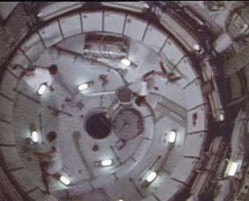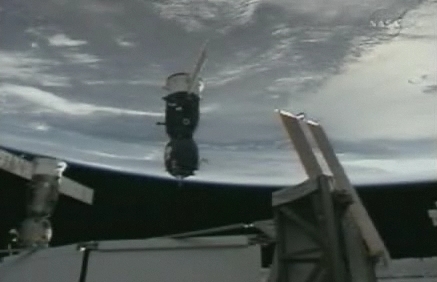[/caption]The Soyuz TMA-13 carrying Expedition 18 to the International Space Station (ISS) has successfully docked, delivering astronaut Mike Fincke, cosmonaut Yuri Lonchakov and space tourist Richard Garriott. The Soyuz spaceship docked with the Zarya module ahead of schedule over breathtaking views of southern Asia. Richard Garriott, a 47 year-old computer games entrepreneur and son of retired US astronaut Owen Garriott, spent $30 million for the privilege of spending ten days travelling to, and living on the orbital outpost. To appreciate how the Earth has changed in the 35 years since his father first looked down on Earth from the US Skylab space station, Garriott Jr. will spend some of his time taking photos of our planet so the images can be compared…
It looked like a flawless docking procedure between the Soyuz spacecraft and the ISS over the scenic backdrop of the Earth. Soyuz gently floated toward its dock with the Russian-built Zarya module along side the Soyuz TMA-12 that carried Expedition 17 to the station back in April. The already parked Soyuz will be the return vehicle in eight days time (on October 23rd) for cosmonauts Sergei Volkov and Oleg Kononenko who will chaperone Richard Garriott back to solid ground at the end of his space “vacation.” Volkov and Kononenko, members of Expedition 17 have spent six months in space.
View the Soyuz TMA-13 dock with the space station »

“I have been trying to figure out where on the International Space Station could this best be performed,” Richard said. “One of the great things about Skylab is that it had this massive internal volume and this nice ring of lockers that gave you a relatively smooth surface to make that attempt and a reasonable diameter so that at a nice jog pace, the centrifugal force would do a reasonable job of holding you to the outside wall. The ISS’s diameter is much smaller.” So it would appear that “running the lockers” as Owen called it, will not be possible on board the ISS. I guess they don’t make space stations like they used to…
Jogging inside the space station to one side, the Expedition 18 crew will begin to supervise the start-up of new life-support equipment for the station. This is one of the steps to ensure that the station can accommodate six full-time crewmembers as from the planned expansion in May 2009.
Sources: BBC [1] [2], collectSPACE

